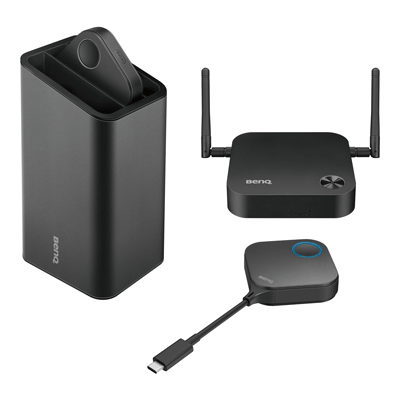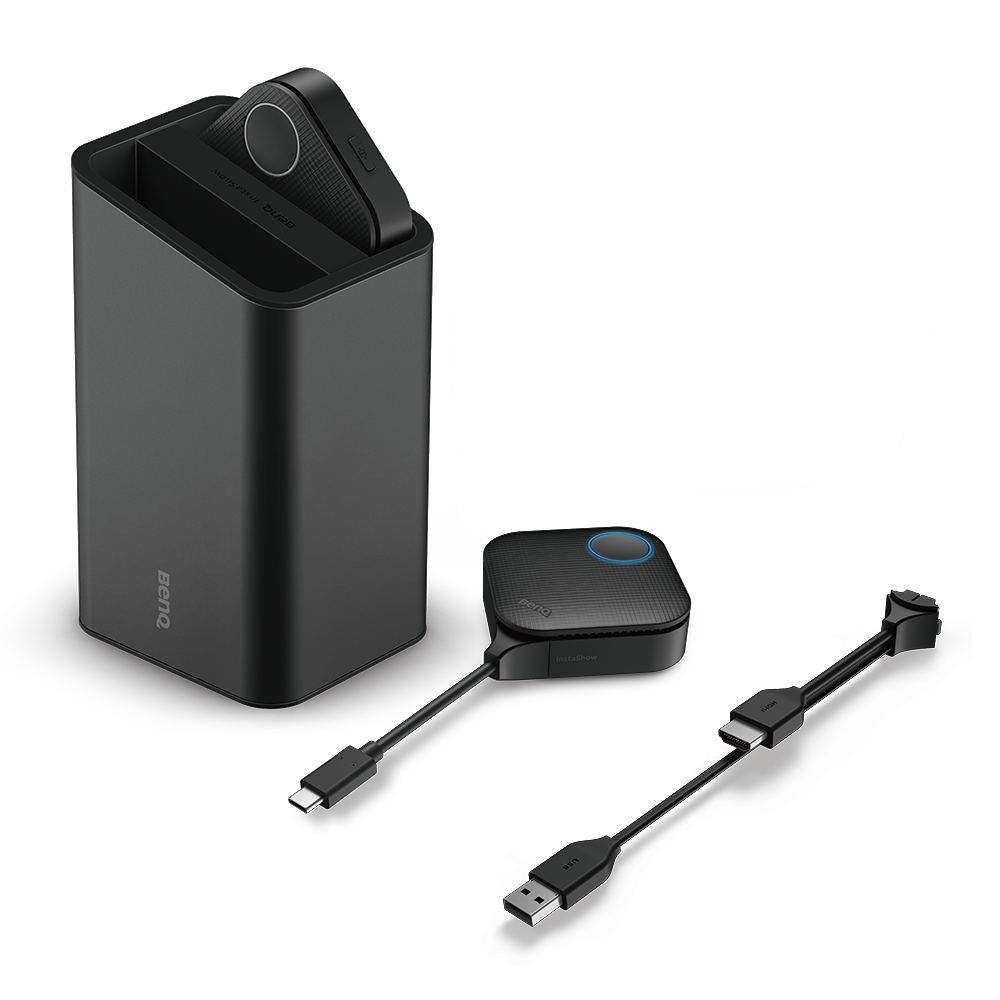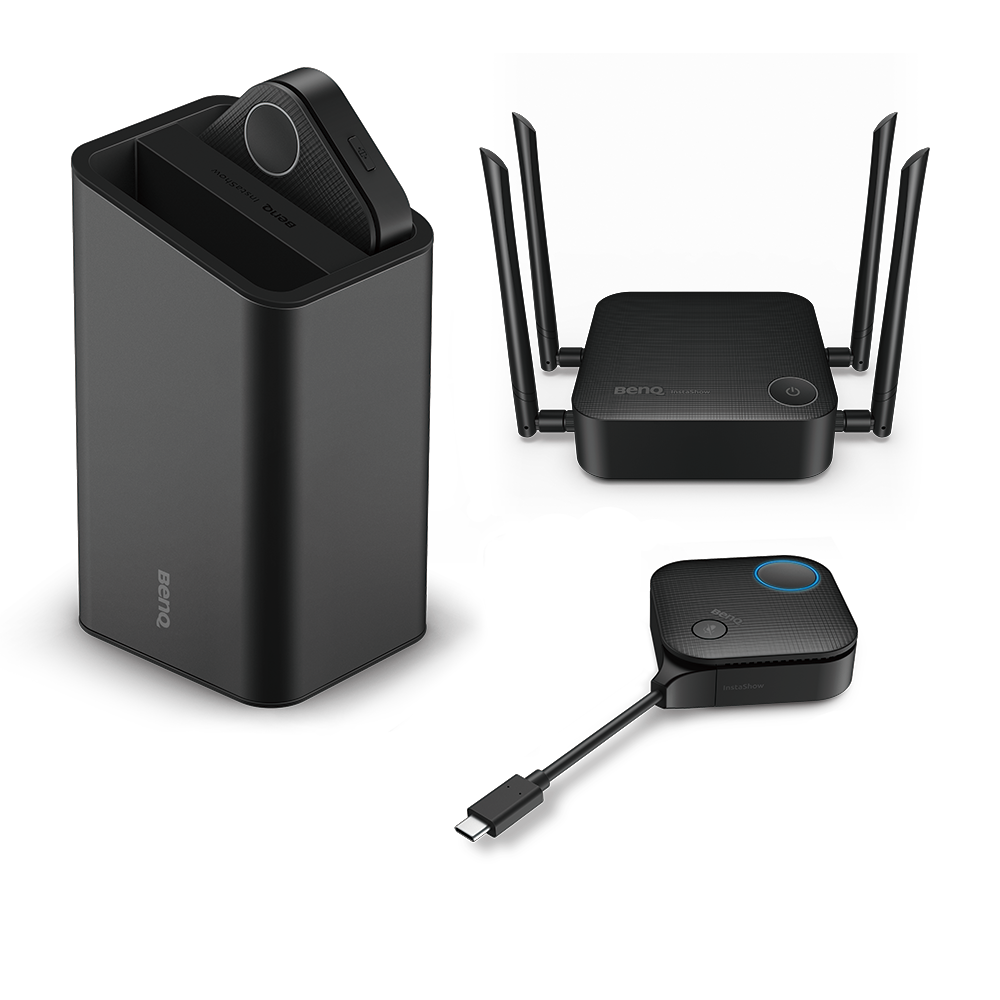How to Select a Wireless Presentation System
- BenQ
- 2024-04-29
For the last two decades, sharing a screen in a meeting room required cables, AV switchers, and touch panels. These systems typically start at 9,000 euros plus custom programming.

Today’s new HDMI wireless presentation and conferencing systems offer far more flexibility and ease of use – at a fraction of the cost of a traditional wired system. But how do you pick the best one for your needs? There are three major types of wireless presentation systems available today:
- Button Based Solutions – Use a physical connection to your notebook for screen mirroring and video conferencing.
- Wi-Fi Network Hub Solutions – Use the company Wi-Fi network to connect your notebook.
- Wireless HDMI TV Solutions – Use streaming protocols built into your PC
We will look at the three types of presentations solutions to look at the pros and cons of each system and what the trade-offs are based on your usage models. The key factors we will look at will be:
- How easy they are to use, especially for visitors?
- How much do they cost and how much IT support is needed to setup and manage?
- How do these systems secure your presentation content from hackers and unauthorised viewing?
Button-Based Solutions
These systems use physical button transmitter that connects to a visitor’s laptop and wirelessly transmits the HDMI signal to a receiver located near the projector or flat panel. To switch presenters, the new presenter simply presses their button and the screen switches to their notebook or device. These systems also have major security advantages of these over generic systems since the wireless signal is encrypted to keep hackers and sniffers from viewing the signal on an unauthorised receiver and are CVSS 3.0 certified
From a set up perspective, they are IT-friendly and easy to install for basic screen mirroring, since the receivers set up their own hidden wireless network and don’t require any special IT support for basic functionality. For a typical meeting, they can split the screen to handle multiple presenters, and have the ability to use an interactive display to control your presentation.
While most video conferencing in a meeting room is done on a dedicated PC, the BenQ InstaShow VS and Barco Clickshare both have the ability to support video conferencing. Simply plug in your webcam and microphone to the receiver, and you can support any video conferencing system using your notebook. The InstaShow adds another layer of security by enabling visitors to use the button to connect to the internet – without having to login to the main network.
The BenQ InstaShow’s unique feature is that it does not require any special software or app to work for wireless presentation screen mirroring, enabling meeting room visitors to use to quickly connect to the system. It can also connect to other types of devices such as Chromebooks, media players, and is capable of wirelessly streaming HDCP content such as movies or video clips.

The BenQ InstaShow VS20 Wireless Presentation System comes with two transmitters and a tabletop holder and support for 4K UHD resolution.
Wi-Fi Network Hub-Based Solutions
These solutions utilise the company network to enable laptops and other devices to share a screen. The system uses a receiver hub that is connected to the corporate network, similar to the receivers used in the hardware approach used by Barco and BenQ but relies on specialised software apps to capture and transmit the signal to the correct screen over the enterprise WiFi network.
Setup and Ease of Use
Wi-Fi typically requires visitors and employees to load software onto their notebooks.
For a visitor to use a system, they will need to:
- Install the manufacturer’s display application software onto their notebook or device
- Log onto the correct enterprise network to access the receiver
- Pick the correct display receiver

There are two primary disadvantages of the Wi-Fi network hub-based solution. First, the system typically requires a proprietary app to be loaded onto the laptop, which can be a major problem when a visitor does not have the rights – or is concerned that the software could contain malware or other hidden codes. Many companies “lock down” their notebooks from third party software to remove the threat of malware. This could delay a meeting – or cause the system to be unusable to a visitor.
The second disadvantage is that these devices need to be installed and managed by IT staff . Typically, the visitor’s notebook used for the presentation must be logged on to the same network as the presentation receiver hub. Since meeting rooms represent the most exposure to external threats, these might be set up on different VLAN networks, which would require a more complicated setup and security protection from the IT department, including specific port usage. In addition, the bandwidth requirement to manage video and other rich content could require changing network priorities or settings. Wi-Fi network solutions are completely dependent upon the performance of the corporate network.
TV-Based Wireless HDMI Transmitters / Receivers
The third type of wireless HDMI solution is designed for consumers to share video content from a source, such as a game console, to a television and eliminate the need for a HDMI cable. These systems have the advantage of being less expensive than the other solutions and easy to set up. Most systems use a single transmitter that attaches to the HDMI port on a computer, with power coming from the USB port or DC power source. The receiver is attached to the display and configured with a remote.
The major disadvantage of these systems is that they do not provide any encryption or other security protection to protect the information sent from the transmitter to be received by an unauthorised third party. While this is not a major concern in a home environment transmitting a movie to a projector, it is a significant risk in a corporate or engineering environment where company information could be stolen.

The second disadvantage is that only one transmitter is linked to the receiver , making it difficult for multiple presenters to share their screens in a collaborative manner. This solution is best suited for a consumer application to overcome cabling issues or applications where there is no data confidentiality concern (such as a small house of worship). There are a number of vendors that offer these solutions including Nyrius, IoGear, and StarTech.
Comparison Table
Here is a summary of popular models of different types of wireless presentation systems. As you can see, some models require annual subscriptions after the initial purchase to keep certain features and for security updates. BenQ InstaShow doesn’t require any subscriptions and new feature updates are free over the product lifetime.
Decision Point |
Hardware Based BenQ InstaShow WDC10 |
Hardware Based BenQ InstaShow VS10 |
Wi-Fi Based Airtame 2 |
Wi-Fi Based Mersive Solstice Pod |
TV Based StarTech Wireless HDMI |
Decision Point Usage Model | Hardware Based BenQ InstaShow WDC10 ·Plug in ·Push Button to present | Hardware Based BenQ InstaShow VS10 · Plug in ·Push Button to present | Wi-Fi Based Airtame 2 ·Load manufacturer app · Login to network · Select Screen · Present | Wi-Fi Based Mersive Solstice Pod · Load manufacturer app · Login to network · Select Screen · Present | TV Based StarTech Wireless HDMI · Attach Transmitter · Change source on TV · Present |
Decision Point Wireless Encryption | Hardware Based BenQ InstaShow WDC10 Yes | Hardware Based BenQ InstaShow VS10 Yes | Wi-Fi Based Airtame 2 No | Wi-Fi Based Mersive Solstice Pod Yes | TV Based StarTech Wireless HDMI No |
Decision Point Third Party CVSS Security Certification | Hardware Based BenQ InstaShow WDC10 Yes | Hardware Based BenQ InstaShow VS10 Yes | Wi-Fi Based Airtame 2 No | Wi-Fi Based Mersive Solstice Pod No | TV Based StarTech Wireless HDMI No |
Decision Point Video Conferencing | Hardware Based BenQ InstaShow WDC10 No | Hardware Based BenQ InstaShow VS10 Yes | Wi-Fi Based Airtame 2 No | Wi-Fi Based Mersive Solstice Pod Yes | TV Based StarTech Wireless HDMI No |
Decision Point Touch Back control for interactive display | Hardware Based BenQ InstaShow WDC10 No | Hardware Based BenQ InstaShow VS10 Yes | Wi-Fi Based Airtame 2 No | Wi-Fi Based Mersive Solstice Pod Yes | TV Based StarTech Wireless HDMI No |
Decision Point Split Screen | Hardware Based BenQ InstaShow WDC10 No | Hardware Based BenQ InstaShow VS10 Yes | Wi-Fi Based Airtame 2 No | Wi-Fi Based Mersive Solstice Pod Yes | TV Based StarTech Wireless HDMI No |
You Might Also Like
-
Trends & Knowledge
How to Choose a Suitable Wireless Presentation System for Hybrid Meetings
A WPS suitable for the hybrid meeting era is one that is able to efficiently broadcast all the elements. But how to choose a suitable wireless presentation system for hybrid meetings…
2023.03.24 -
Trends & Knowledge
BYOM and the Most Effective Wireless Conferencing Solutions
The BenQ InstaShow® VS20 system delivers enterprise-class video conferencing, screen sharing, and hosting for multiple BYOM participants, promoting successful hybrid work.
2023.05.12 -
Trends & Knowledge
Recommended BYOD and BYOM Security Setups and Best Practices
Learn about the data security needs and setup recommendations for bring your own device (BYOD) and bring your own meeting (BYOM)
2023.08.28




